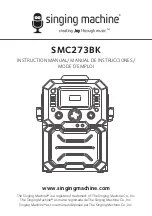
WELDER OPERATION
DUTY CYCLE
Duty Cycle is the percentage of time the load is being
applied in a 10 minute period. For example a 60% duty
cycle, represents 6 minutes of load and 4 minutes of no
load in a 10 minute period.
ELECTRODE INFORMATION
For any electrode the procedures should be kept within the
rating of the machine. For information on electrodes and
their proper application see (www.lincolnelectric.com) or
the appropriate Lincoln publication.
The VANTAGE® 500 (CE) can be used with a broad range
of DC stick electrodes. The MODE switch provides two
stick welding settings as follows:
CONSTANT CURRENT (CC-STICK) WELDING
The CC-STICK position of the MODE switch is designed
for horizontal and vertical-up welding with all types of elec-
trodes, especially low hydrogen. The OUTPUT CONTROL
dial adjusts the full output range for stick welding.
B-5
OPERATION
B-5
VANTAGE
®
500 (CE)
NOTE
: If the unit fails to start turn Run/Stop switch
to off and repeat step 3 through step 7 after
waiting 30 seconds.
• Do not allow the starter motor to run continuously
for more than 20 seconds.
• Do not push the START button while the engine
is running because this can damage the ring
gear and/or the starter motor.
• IF the Engine Protection or Battery Charging
Lights do “not” turn off shortly after starting the
engine shut off the engine immediately and
determine the cause.
------------------------------------------------------------------------
NOTE
: When starting for the first time, or after and
extended period of time of not operating, it will take
longer than normal to start because the fuel pump
has to fill the fuel system. For best results, bleed the
fuel system as indicated in Maintenance Section of
this manual.
STOPPING THE ENGINE
Remove all welding and auxiliary power loads and
allow the engine to run at low idle speed for a few
minutes to cool the engine.
STOP
the engine by placing the RUN-STOP switch in
the STOP position.
NOTE:
A fuel shut off valve is located on the fuel pre-filter.
CAUTION
The ARC CONTROL dial sets the short circuit current
(arc-force) during stick welding to adjust for a soft or
crisp arc. Increasing the number from -10(soft) to
+10(crisp) increases the short circuit current and pre-
vents sticking of the electrode to the plate while welding.
This can also increase spatter. It is recommended that
the ARC CONTROL be set to the minimum number
without electrode sticking. Start with the dial set at 0.
NOTE:
Due to the low OCV with the VRD on, a very
slight delay during striking of the electrodes may occur.
Due to the requirement of the resistance in the circuit to
be low for a VRD to operate, a good metal-to-metal con-
tact must be made between the metal core of the elec-
trode and the job. A poor connection anywhere in the
welding output circuit may limit the operation of the
VRD. This includes a good connection of the work
clamp to the job. The work clamp should be connected
as close as practical to where the welding will be per-
formed.
A. For New Electrodes
E6010 - Touch, Lift to Start the Arc
E7018, E7024 - Touch, Rock Back and Forth in Joint,
Lift .
Once the arc is started, normal welding technique for
the application is then used.
B. For Re-Striking Electrodes
Some electrodes form a cone at the end of the elec-
trode after the welding arc has been broken, particularly
iron powder and low hydrogen electrodes. This cone will
need to be broken off in order to have the metal core of
the electrode make contact.
E6010 - Push, Twist in Joint, Lift
E7018, E7024 - Push, Rock Back and Forth in Joint,
Lift.
Once the arc is started, normal welding technique for
the application is then used.
For other electrodes the above techniques should be
tried first and varied as needed to suit operator prefer-
ence. The goal for successful starting is good metal to
metal contact.
For indicator light operation, see table B.1.
DOWNHILL PIPE Welding
This slope controlled setting is intended for "out-of-posi-
tion" and "down hill" pipe welding where the operator
would like to control the current level by changing the
arc length.
Содержание Vantage 500 CE
Страница 33: ...F 1 DIAGRAMS F 1 VANTAGE 500 CE ...
Страница 34: ...F 2 DIAGRAMS F 2 VANTAGE 500 CE ...
Страница 35: ...F 3 DIAGRAMS F 3 VANTAGE 500 CE ...
Страница 36: ...F 4 DIAGRAMS F 4 VANTAGE 500 CE ...
Страница 41: ...NOTES VANTAGE 500 CE ...
















































